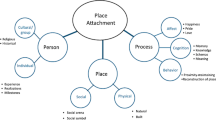Abstract
We aimed to assess how strong was the relationship between territorial identities and place attachment at the neighbourhood level. To achieve this goal, we had two objectives. The first was to explore how locals used and thought about Mănăştur neighbourhood of Cluj-Napoca City, in Romania, considering how identities, webs of familiarity, and attachments were exhibited in a local newspaper. The second objective was to find out whether local initiatives and practices enhanced people’s place attachment to their neighbourhood. For this two-fold purpose, we used the case study approach and discourse analysis to process the research material represented by the community-led newspaper: Buletin de Mănăştur. The research questions were the following: How is the identity of the neighbourhood and place attachment reflected and constructed in the newspaper? How do representations about the neighbourhood and bottom-up civic initiatives impact inhabitants’ place attachment? Which are the features of attachment in Mănăştur? Are research results relevant to inform spatial planning policy decisions? We did not measure attachment to place, but we did explore how the distinctiveness of the neighbourhood and place attachment were represented. We also discussed the diversity and complexity of processes that contributed to the construction of territorial identity and place attachment.
Access this chapter
Tax calculation will be finalised at checkout
Purchases are for personal use only
Similar content being viewed by others
References
Altman, I., & Low, M. S. (Eds.). (1992). Place attachment. Plenum Press.
Banini, T. (2021). Chapter 1. Towards a methodology for constructing local territorial identities. In O.-R. Ilovan (Ed.), Territorial identities in action (pp. 13–39). Presa Universitară Clujeană.
Banini, T., & Ilovan, O.-R. (2021). Introduction: Dealing with territorial/place identity representations. In T. Banini & O.-R. Ilovan (Eds.), Representing place/territorial identity in Europe. Discourses, images, and practices (pp. 1–19). Springer. https://doi.org/10.1007/978-3-030-66766-5_1
Bonnes, M., Mannetti, L., Secchiaroli, G., & Tanucci, G. (1990). The city as a multi-place system: An analysis of people-urban environment transactions. Journal of Environmental Psychology, 10, 37–65.
Buletin de Mănăştur. (2017, 2018, 2019). 1st to 7th editions. Cluj-Napoca: Arcadia Media S.R.L.
Buttimer, A., & Seamon, D. (Eds.). (1980). The human experience of space and place. Croon Helm.
Gunder, M. (2005). The production of desirous space: Mere fantasies of the utopian city? Planning Theory, 4(2), 173–199.
Hummon, M. D. (1992). Community attachment. Local sentiment and sense of place. In I. Altman & M. S. Low (Eds.), Place attachment (pp. 253–278). Plenum Press.
Husseini de Araújo, S., & Batista da Costa, E. (2017). From social hell to heaven? The intermingling processes of territorial stigmatisation, agency from below and gentrification in the Varjão, Brazil. In P. Kirkness & A. Tijé-Dra (Eds.), Negative neighbourhood reputation and place attachment. The production and contestation of territorial stigma (pp. 158–177). Routledge.
Ilovan, O.-R., Medeșan, S., Colcer, A.-M., Adorean, E.-C., Dulamă, M. E., Cîineanu, M.-D., & Benedek, R. (2020). In V. Chiș (Ed.), Raising civic awareness and involvement through urban regeneration: At the playgrounds, Mănăștur (Vol. 85, pp. 273–281). 7th Edition of Education Reflection Development International Conference 2019, European Proceedings of Social and Behavioural Sciences. https://doi.org/10.15405/epsbs.2020.06.27
Iwańczak, B., & Lewicka, M. (2020). Affective map of Warsaw: Testing Alexander’s pattern language theory in an urban landscape. Landscape and Urban Planning, 204, Art. no. 103910. https://doi.org/10.1016/j.landurbplan.2020.103910
Jorgensen, B. S., & Stedman, R. C. (2001). Sense of place as an attitude: Lakeshore owners’ attitudes toward their properties. Journal of Environmental Psychology, 21, 233–248.
Kirkness, P., & Tijé-Dra, A. (Eds.). (2017a). Negative neighbourhood reputation and place attachment. The production and contestation of territorial stigma. Routledge.
Kirkness, P., & Tijé-Dra, A. (2017b). Voices from the quartiers populaires: Belonging to stigmatised French urban neighbourhoods. In P. Kirkness & A. Tijé-Dra (Eds.), Negative neighbourhood reputation and place attachment. The production and contestation of territorial stigma (pp. 119–137). Routledge.
Lewicka, M. (2005). Ways to make people active: Role of place attachment, cultural capital and neighborhood ties. Journal of Environmental Psychology, 4, 381–395.
Lewicka, M. (2008). Place attachment, place identity, and place memory: Restoring the forgotten city past. Journal of Environmental Psychology, 28(3), 209–231. https://doi.org/10.1016/j.jenvp.2008.02.001
Lewicka, M., Rowinski, K., Iwanczak, B., Balaj, B., Kula, A. M., Oleksy, T., Prusik, M., Torunczyk-Ruiz, S., & Wnuk, A. (2019). On the essentialism of places: Between conservative and progressive meanings. Journal of Environmental Psychology, 65, Art. no. 101318. https://doi.org/10.1016/j.jenvp.2019.101318
Low, M. S., & Altman, I. (1992). Place attachment. A conceptual inquiry. In I. Altman & M. S. Low (Eds.), Place attachment (pp. 1–12). Plenum Press.
Mannarini, T., Tartaglia, S., Fedi, A., & Greganti, K. (2006). Image of neighborhood, self-image and sense of community. Journal of Environmental Psychology, 26(3), 202–214. https://doi.org/10.1016/j.jenvp.2006.07.008
Manzo, C. L., & Devine-Wright, P. (Eds.). (2014). Place attachment. Advances in theory, methods and applications. Routledge.
Massey, D. (1994). Space, place and gender. Polity Press.
Medeșan, S., & Panait, L. (2017). cARTier. Interventii Periferice [cARTier. Peripheral interventions]. Idea.
Paasi, A. (1986). The institutionalization of regions: A theoretical framework for understanding the emergence of regions and the constitution of regional identity. Fennia, 164(1), 105–146.
Pellow, D. (1992). Spaces that teach. Attachment to the African compound. In I. Altman & M. S. Low (Eds.), Place attachment (pp. 187–210). Plenum Press.
Pohl, L. (2017). Imaginary politics of the branded city: Right-wing terrorism as a mediated object of stigmatisation. In P. Kirkness & A. Tijé-Dra (Eds.), Negative neighbourhood reputation and place attachment. The production and contestation of territorial stigma (pp. 27–41). Routledge.
Relph, E. (1976). Place and placelessness. Pion.
Scannell, L., & Gifford, R. (2010a). Defining place attachment: A tripartite organizing framework. Journal of Environmental Psychology, 30, 1–10.
Scannell, L., & Gifford, R. (2010b). The relations between natural and civic place attachment and pro-environmental behavior. Journal of Environmental Psychology, 30(3), 289–297. https://doi.org/10.1016/j.jenvp.2010.01.010
Seamon, D. (2014). Chapter 1. Place attachment and phenomenology. The synergistic dynamism of place. In C. L. Manzo & P. Devine-Wright (Eds.), Place attachment. Advances in theory, methods and applications (pp. 11–22). Routledge.
Sebastien, L. (2020). The power of place in understanding place attachments and meanings. Geoforum, 108, 204–216. https://doi.org/10.1016/j.geoforum.2019.11.001
Tuan, Y. F. (1974). Topophilia: A study of environmental perception, attitudes, and values. NJ: Prentice Hall.
Tuan, Y. F. (1980). Rootedness versus sense of place. Landscape, 4, 3–8.
Zhang, Y. (2017). ‘This is my “Wo”’. Making home in Shanghai’s lower quarter. In P. Kirkness & A. Tijé-Dra (Eds.), Negative neighbourhood reputation and place attachment. The production and contestation of territorial stigma (pp. 138–157). Routledge.
Acknowledgements
We gratefully acknowledge the support offered by Mihai Armanca, the editor-in-chief of the newspaper Buletin de Mănăştur. He answered our questions about the newspaper, about the editors’ aims and intentions, and he kindly helped us during the process of collecting the research material we needed.
Note
All translations from Romanian are by the authors.
Author information
Authors and Affiliations
Corresponding author
Editor information
Editors and Affiliations
Rights and permissions
Copyright information
© 2022 The Author(s), under exclusive license to Springer Nature Switzerland AG
About this chapter
Cite this chapter
Ilovan, OR., Răcăşan, B.S. (2022). Constructing Place Attachment and Planning the Future of the Neighbourhood. Case Study: Mănăştur, Cluj-Napoca, Romania. In: Ilovan, OR., Markuszewska, I. (eds) Preserving and Constructing Place Attachment in Europe. GeoJournal Library, vol 131. Springer, Cham. https://doi.org/10.1007/978-3-031-09775-1_6
Download citation
DOI: https://doi.org/10.1007/978-3-031-09775-1_6
Published:
Publisher Name: Springer, Cham
Print ISBN: 978-3-031-09774-4
Online ISBN: 978-3-031-09775-1
eBook Packages: Social SciencesSocial Sciences (R0)




